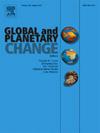Modeling of non-floodplain wetlands in an upstream basin of the Pampa Plain, Argentina, during current hydro-climatic extreme conditions: Geomorphological thresholds controlling hydrodynamics
IF 4
1区 地球科学
Q1 GEOGRAPHY, PHYSICAL
引用次数: 0
Abstract
This contribution analyzes the processes related to the development of small, temporary, non-floodplain wetlands (NFWs) of neotectonic origin in the loessic North Pampa Plain under wet conditions. The study focuses on the Vila-Cululú upstream sub-basin (973 km2), a tributary of the Salado River belonging to the Paraná River basin. Under wet conditions, the flat landscape influences the surface runoff and favors the development of temporary NFWs, increasing flood vulnerability and compromising human activities. Late Pleistocene fluvial palaeochannels intercept small tectonic depressions and significantly restrict the present drainage network (low-order streams and artificial channels). This research involves an integrated approach, including geomorphic and morphometric analyses based on remotely sensed satellite imagery in a GIS platform and fieldwork, and 2D hydrologic-hydraulic simulations using HydroBID Flood to capture the system behavior during a rainfall event that recently occurred over several weeks and caused extended flooded areas. Simulation results show that the model significantly captures the system's hydrodynamics. The resulting flooded areas were comparable to those obtained from the analysis of satellite images. The dendritic runoff pattern towards the tectonic depressions, the water storage evolution, and the hydraulic connectivity were numerically replicated. Results indicates the Vila-Cululú sub-basin shows a significant delay in the hydraulic response downstream since the system must first satisfy groundwater and surface water storage. Once storage capacity is exceeded, the hydraulic behavior results in a dynamic process that involves the spilling and merging of ponds generated in small deflation hollows, generally nested within fluvial palaeochannels. Such a hierarchical structure controls surface runoff towards the shallow tectonic depressions. This mechanism allows the development of NFWs as simulation time progresses. Additionally, the surface runoff flow pattern exhibits significant lateral mobility and low connectivity downstream, although this varies depending on the magnitude of the storm. Despite the dense network of artificial channels developed to evacuate water excess to the outlet, geomorphological thresholds further control hydrodynamics by adding to surface water storage and limiting channel conveyance. Identifying critical geomorphological thresholds add to the knowledge of different levels of hydrological connectivity, providing a better assessment of flood hazards. This work is one of the first studies in North Pampa in which hydrological and geomorphological data are combined to explain the present hydrodynamics and that could be applied to other fluvial basins of large plains of South America.
当前水文气候极端条件下阿根廷潘帕平原上游盆地非洪泛平原湿地的模拟:控制水动力学的地貌阈值
本文分析了湿润条件下黄土北潘帕平原新构造成因的小型临时非洪泛平原湿地(NFWs)的发育过程。研究的重点是Vila-Cululú上游子流域(973 km2),这是属于帕拉纳河流域的萨拉多河的一条支流。在潮湿条件下,平坦的景观影响地表径流,有利于临时NFWs的发展,增加了洪水脆弱性,损害了人类活动。晚更新世河流古河道阻断了小型构造洼地,严重制约了目前的水系网(低阶河流和人工河道)。该研究采用了一种综合方法,包括基于GIS平台和实地调查的遥感卫星图像的地貌和形态测量学分析,以及利用HydroBID Flood进行的二维水文-水力模拟,以捕捉最近几周内发生的降雨事件中系统的行为,并导致大面积洪水泛滥。仿真结果表明,该模型较好地反映了系统的流体力学特性。由此得出的洪水面积与通过卫星图像分析得出的结果相当。数值模拟了向构造凹陷方向的枝状径流格局、蓄水演化和水力连通性。结果表明,Vila-Cululú子流域在下游表现出明显的水力响应延迟,因为该系统必须首先满足地下水和地表水的储存。一旦超过储存能力,水力行为就会导致一个动态过程,包括在小的收缩空洞中产生的池塘的溢出和合并,这些空洞通常嵌套在河流古河道中。这种层次结构控制着流向浅层构造洼地的地表径流。这种机制允许NFWs随着模拟时间的推移而发展。此外,地表径流模式表现出显著的横向流动性和下游低连通性,尽管这取决于风暴的强度。尽管开发了密集的人工水道网络,将多余的水排到出口,但地貌阈值通过增加地表水储存和限制河道输送进一步控制了水动力学。确定关键的地貌阈值有助于了解不同程度的水文连通性,从而更好地评估洪水灾害。这项工作是在北潘帕进行的首批研究之一,其中将水文和地貌数据结合起来解释当前的水动力学,并可应用于南美洲大平原的其他河流盆地。
本文章由计算机程序翻译,如有差异,请以英文原文为准。
求助全文
约1分钟内获得全文
求助全文
来源期刊

Global and Planetary Change
地学天文-地球科学综合
CiteScore
7.40
自引率
10.30%
发文量
226
审稿时长
63 days
期刊介绍:
The objective of the journal Global and Planetary Change is to provide a multi-disciplinary overview of the processes taking place in the Earth System and involved in planetary change over time. The journal focuses on records of the past and current state of the earth system, and future scenarios , and their link to global environmental change. Regional or process-oriented studies are welcome if they discuss global implications. Topics include, but are not limited to, changes in the dynamics and composition of the atmosphere, oceans and cryosphere, as well as climate change, sea level variation, observations/modelling of Earth processes from deep to (near-)surface and their coupling, global ecology, biogeography and the resilience/thresholds in ecosystems.
Key criteria for the consideration of manuscripts are (a) the relevance for the global scientific community and/or (b) the wider implications for global scale problems, preferably combined with (c) having a significance beyond a single discipline. A clear focus on key processes associated with planetary scale change is strongly encouraged.
Manuscripts can be submitted as either research contributions or as a review article. Every effort should be made towards the presentation of research outcomes in an understandable way for a broad readership.
 求助内容:
求助内容: 应助结果提醒方式:
应助结果提醒方式:


